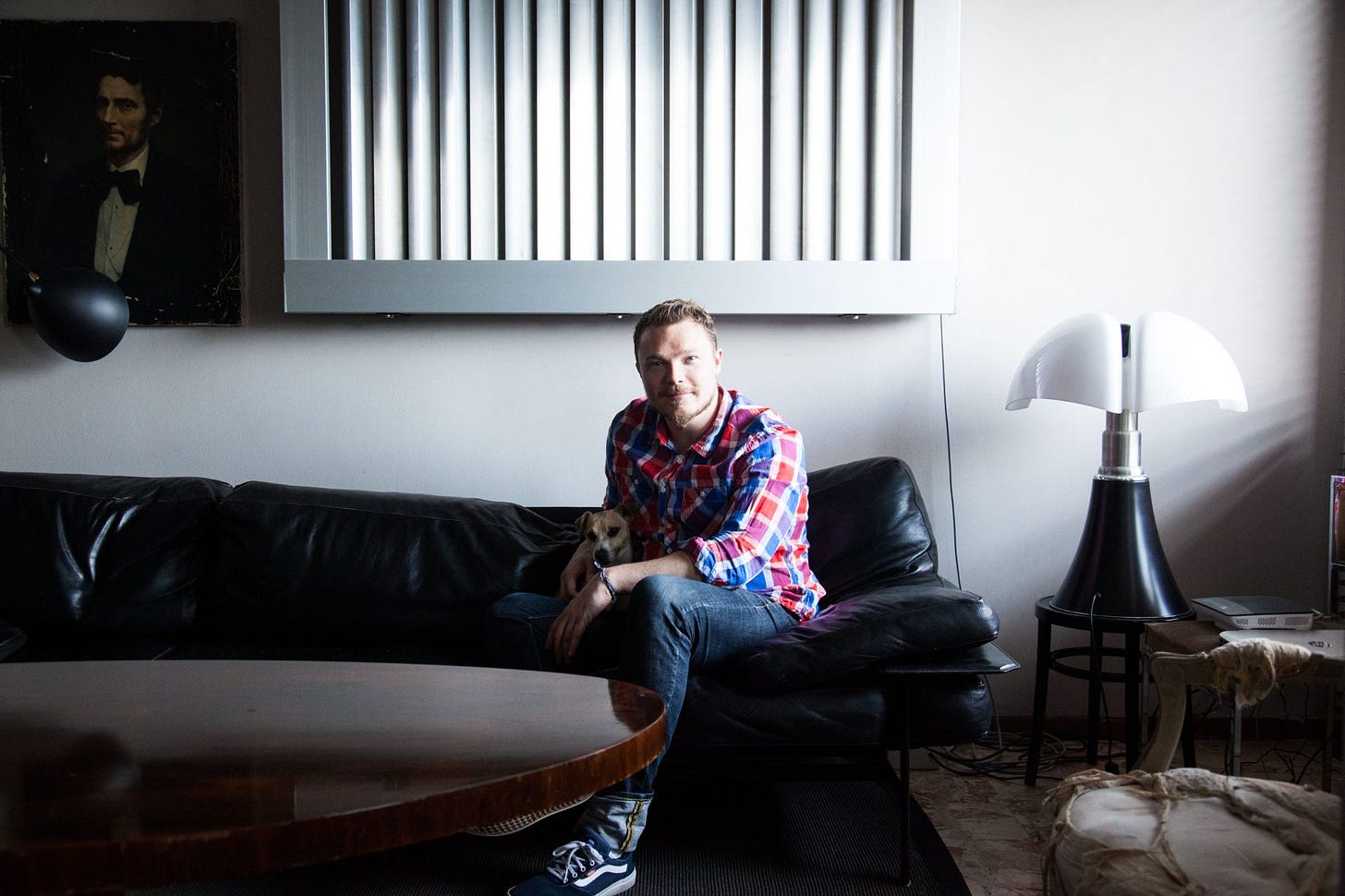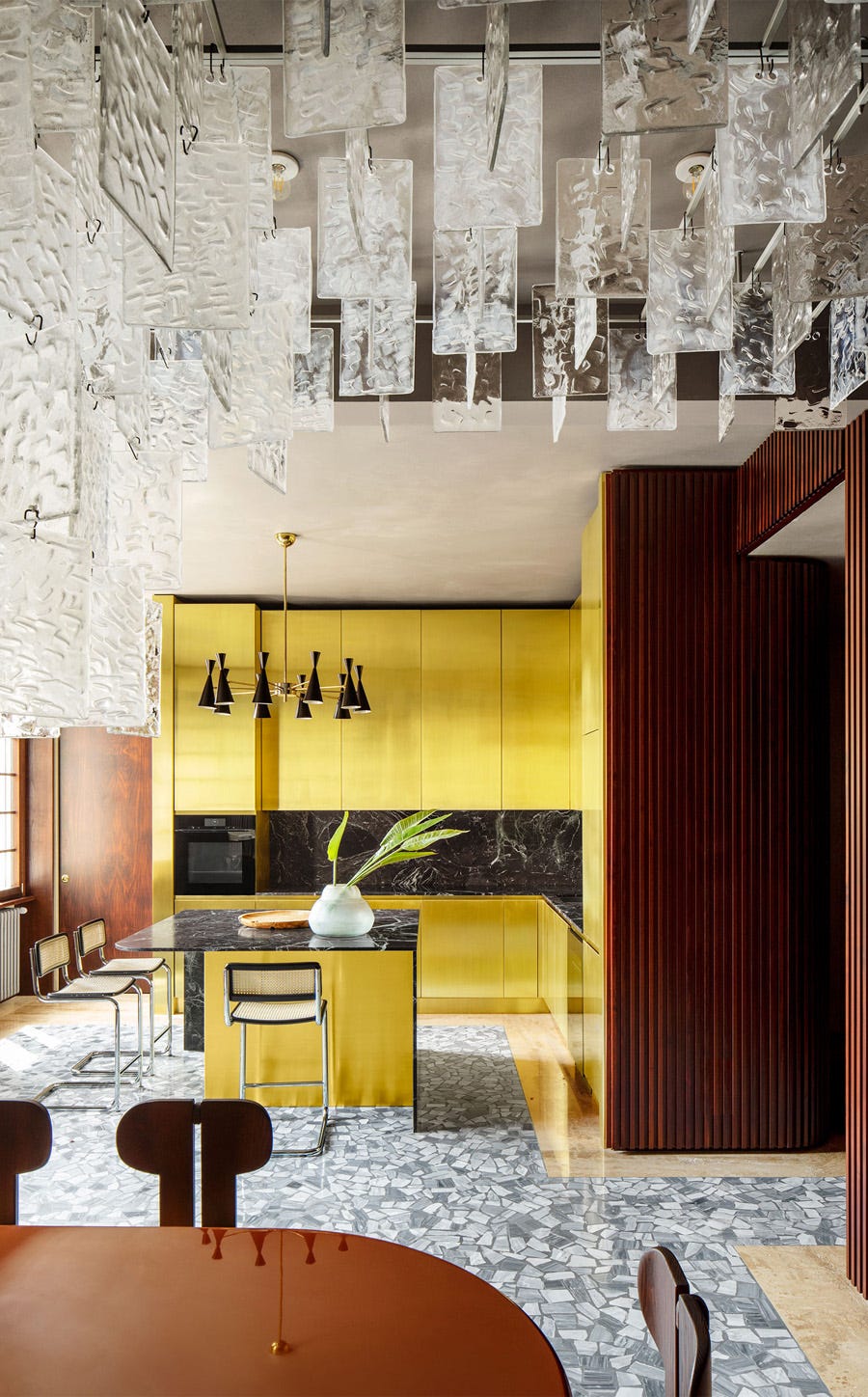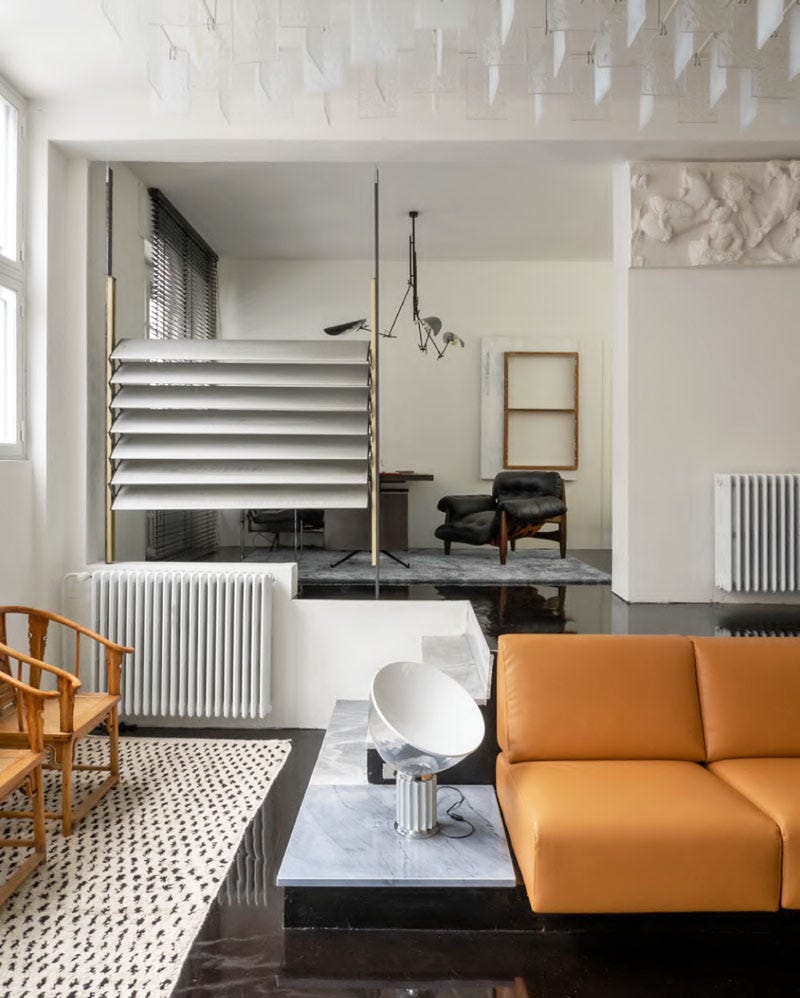In Conversation with Hannes Peer: The Art of Timeless Design
Blending history and modern vision to create enduring designs.
Today, we share a conversation I had with Hannes Peer, a Milan-based architect and interior designer who has quickly become one of the most talented and multidisciplinary designers in recent years.
Hannes approaches every project—whether it’s a house, hotel, or piece of furniture—with a profound understanding of its true meaning. His design process is thoughtful and balanced, blending history with modernity while keeping an eye on both functionality and beauty, always prioritizing his clients' desires.
His multidisciplinary approach mirrors that of architects and designers from the past, those who brought a distinct vision and deep understanding to every stage of a project. It’s no coincidence that he draws inspiration from masters like Carlo Mollino, Le Corbusier, and Frank Lloyd Wright. His work spans many fields, revealing the mind of a true artist. Enjoy the interview.
(Marco Guagliardo - Mid-Century Home’s Editor in Chief)
Audio:
Transcript:
MCH: Hannes Peer is an Italian architect and designer based in Milan. After gaining valuable experience working for renowned international architecture studios in the Netherlands, Germany, and Italy, he decided to open his own architecture and design studio in 2009.
Since then, he has built an impressive portfolio of projects characterized by a deep respect for architectural history and an ongoing commitment to meticulous research. His work spans across various fields, including residential, retail, and hospitality design.
In 2023, he was included in the prestigious AD France magazine’s list of the 100 most influential designers in the world, also known as the AD 100. Hannes Peer, welcome to Mid-Century Home Talks.
Hannes: Thank you very much for having me, and thank you for that wonderful introduction. It’s a pleasure to be here.
MCH: Considering your diverse background and multidisciplinary approach, could you explain how the blending of different disciplines and architectural styles has shaped your design language in your interior architecture projects?
Hannes: Well, that's a great question, but It’s quite a long story. I didn't begin my career by randomly overlapping architectural styles or aesthetics from different eras or places. It’s something that has come with time, with experience, and with exposure to different environments.
I’ve been fortunate enough to work in several countries and, as you mentioned in your introduction, I’ve gained experience working with various renowned architecture firms across the Netherlands, Germany, and Italy before establishing my own studio in 2009.
So, I’ve had the chance to see and absorb a lot of influences before starting my independent journey. My exposure to different cultures, architectural styles, and aesthetics from around the world has been invaluable in shaping my own design language.
For any young architect starting out, I cannot recommend enough the importance of gaining as much experience as possible by working abroad and being exposed to diverse architectural traditions. Don’t stay in one place.
Of course, there are advantages to remaining in a familiar environment, but as an architect, it’s essential to get out there, to see and experience the world. You need to draw influences from different contexts and cultures because the broader your exposure, the richer and more layered your architectural language will become.
For me, I was heavily influenced by the work of Rem Koolhaas, with whom I had the privilege of working for almost two years. Later, I worked with Zwiehacker in Berlin. These experiences exposed me to a wide array of design philosophies and approaches.
The more you see, the more diverse your influences become, and the richer your architectural language will grow over time. As you gather experiences, culture, information, and inspiration, all of this eventually feeds into your own architectural output, making it far more nuanced and compelling.
Additionally, I feel very fortunate to have been born and raised in Europe, where there is a vast and deep cultural heritage. Europe has such a wealth of historical context, and simply living here provides you with a certain “baggage,” or perhaps better phrased, a foundation of cultural knowledge.
This foundation influences how you view and approach design. For instance, we are currently working on a project in Rome at the Baths of Caracalla, which is such a fascinating and historically rich location. When you’re working on a site like that, you have to approach it with open eyes and a willingness to learn from the environment. You have to absorb everything around you because that historical context is something incredibly precious.
It’s not just about designing something new; it’s about respecting and integrating the history of the site into your work. If you’re sensitive enough to your surroundings, your work will naturally be influenced by the context you’re working in.
MCH: That absolutely makes sense. Living in Italy, and more broadly being European, certainly brings a certain weight and responsibility to your shoulders as a designer. But I’m curious, how do you balance the historical elements with contemporary ones? Do you have a particular pattern or framework that you follow, or do you rely more on intuition?
Hannes: It really depends on the context. Every project has its own unique set of requirements, and you can’t approach an 18th-century context, for instance, in the same way you would approach something like the Baths of Caracalla. These are two very different settings, each with its own history and architectural significance. So, my approach has to be adapted to fit the specific context of each project.
In terms of how my own cultural background influences my work, I think that’s something that happens naturally. We are all influenced by our personal experiences and the cultural environments we’ve been exposed to. For example, some people might feel more drawn towards the 17th or 18th centuries, and that will reflect in how they approach a project from that era.
What’s important is to take the time to really study and understand the context of the place you’re working in. One thing I always recommend to young architects is to read as much as possible about the history and culture of the site they’re designing for. This is a way of showing respect for the place and its historical significance. It’s crucial to educate yourself about the context you’re entering before you begin to design.
At the same time, you shouldn’t be overwhelmed by the weight of that historical context. I’ve encountered many architects who feel crushed by the strength of the history of the places they’re working in, and that’s not the right approach either.
The key is to absorb the energy and power of the context, to learn from it, and then to react to it in your own unique way. Once you’ve gathered all this information about the place, you can make your own interpretation of it, and that’s what will make your work both respectful and original.
MCH: In preparation for this interview, I came across a concept that you’ve discussed in previous occasions as well—the idea of nostalgic utopia I find it really interesting and would like for you to explain what it means in more detail.
Hannes: Yes, of course. The concept of nostalgic utopia isn’t necessarily something new, but it’s a way of summarizing how I think architects should approach any project.
On one side, you have nostalgia, which represents a respect for history, for the past, and for the context in which you’re building. This is the part of the concept that relates to everything I’ve just been talking about—the importance of understanding the history and culture of the place you’re working in.
On the other hand, as architects, we are always projecting. The very nature of our work is forward-looking—we are envisioning and creating something for the future. The word “projecting” itself comes from the Latin word *proicere*, which means to “throw forward.” In other words, we are always throwing our ideas forward, into the future.
What I’m against, however, is the idea of a utopia that has no basis in reality. Some architects create these fantastical visions of the future without grounding their designs in the reality of the place they’re working in.
For me, that doesn’t make sense. Before you project into the future, you need to have a solid foundation to build on, and that foundation comes from understanding the past and the context in which you’re working. That’s where the concept of “nostalgic utopia” comes from—it’s about balancing a respect for history and a forward-looking vision. It’s about being rooted in the past while also being creative and innovative in imagining the future.
This concept also ties into sustainability, which is something that is increasingly important in architecture today and I care deeply about. Sustainability isn’t just about using environmentally friendly materials; it’s about creating something that will last, something that is timeless. When you have a solid foundation and a deep understanding of the context, you can create something that is both forward-looking and enduring.
MCH: It’s a very interesting concept and one that makes a lot of sense, especially in today’s world. You’ve mentioned in other interviews that you draw inspiration from architects like Frank Lloyd Wright or Carlo Mollino to mention a few. How have they influenced your work?
Hannes: Oh, they’ve had a huge influence on me. Carlo Mollino, in particular, was a master at taking risks in his designs. He had an incredible talent for mixing different elements, putting together things that seemed like they shouldn’t belong, yet somehow making them work. That’s something I’ve always admired about his work.
He was able to take these risks because he had such a deep understanding of architecture and aesthetics. Even today, his work feels contemporary because he was always pushing the boundaries of what was possible.
I recently posted about Carlo Mollino on my Instagram, and it’s fascinating to see how people respond to his work. Sometimes, they even assumed that I designed the interiors I was posting about, which shows just how timeless and modern Mollino’s work remains, even though it was created over 70 years ago. That’s what makes his work so remarkable—it transcends time.
Frank Lloyd Wright is another key influence, but it's hard to single out just one figure. I’ve also been influenced by Le Corbusier and Mies van der Rohe. Each of these masters developed a distinct architectural style over the course of their careers.
What I particularly admire about Le Corbusier is that he wasn’t afraid to evolve and change his style over time. He took risks, and that willingness to explore different avenues is something that resonates with me.
At the same time, I’ve always resisted the idea of having a signature style that’s instantly recognisable. While it would be easier commercially to develop a style that is always recognisable, I’ve always preferred the challenge of evolving and adapting to each project. For me, architecture is about responding to the context, and that means being flexible and open to new ideas.
MCH: That’s an important point. It’s easy to get caught up in trends, especially with the influence of social media and design magazines. How do you navigate those pressures, particularly with the instant gratification that platforms like Instagram promote?
Hannes Peer: Social media has definitely added a new layer of complexity to the world of architecture. Platforms like Instagram push for instant recognition, and that can lead to a lot of pressure to conform to certain trends. But I believe it’s crucial to resist those pressures and stay true to your own principles.
Architecture is a long-term endeavor. If you design a building based on a fleeting trend—whether it’s a color, a material, or a particular style—that building might not stand the test of time.
This approach isn’t just unsustainable, it’s also limiting in terms of creativity. You have to think beyond what’s fashionable right now and consider what will be meaningful in the future.
MCH: It’s easy to see how those pressure points can affect young architects. But as you mentioned, understanding the past is crucial in creating something new.
Hannes Peer: Exactly. When you know where you’re coming from, you can create something new. That’s the essence of nostalgic utopia. It’s about grounding yourself in the past while projecting into the future. But this takes time, and young architects today might struggle with that.
They want quick results, and social media amplifies that impatience. But architecture requires patience and depth. It’s not something you can rush.
MCH: It seems that today’s digital tools can fuel impatience, but as you’ve said, it takes time to do the real research needed for thoughtful architecture.
Hannes Peer: Digital tools offer a lot of possibilities, but they can also encourage shortcuts. I was lucky enough to grow up in both the analogue and digital worlds, so I appreciate the value of both. But I always remind my students to be mindful of how algorithms influence them.
For example, when they use Pinterest to gather inspiration, they need to be aware that what they’re seeing is filtered by the algorithm. It’s important to break free from that and develop their own unique path.
MCH: Breaking out of that influence is a challenge for sure. As the last question I’d like to ask about your approach to interior residential projects. How do you develop a relationship with your clients, and is there a particular method you follow?
Hannes: For residential projects, the relationship with the client is key. It’s a very intimate process. I consider myself a good listener, and I think that’s one of the most important skills an architect can have. Even when a client gives me complete creative freedom, I always try to get a sense of what they truly want, even if they don’t explicitly express it. It’s about reading between the lines and understanding their deeper desires.
Sometimes, it takes time to uncover what the client is really looking for, but I find that’s where the most valuable ideas come from. It’s a process of discovery, and the more you listen, the more you can create something that resonates with the client on a personal level.














